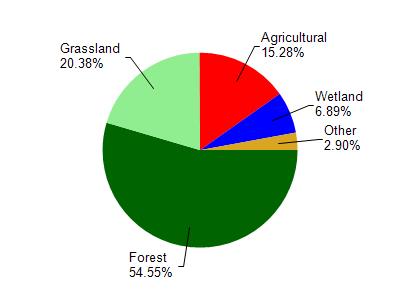Iowa
Yes
No
No
Fish and Aquatic Life
Overview
Cutler Creek is a major tributary to Mill Creek in Iowa County. It is a spring fed stream and
has a high gradient that has caused problems due to heavy erosion during runoff events. A
flood control structure exists on Cutler Creek near its mouth. Currently, the stream supports a
Class II brown trout fishery, but, with proper management and in instream habitat
improvement, the stream shows the potential to be upgraded to a Class I stream.
From: Ripp, Coreen, Koperski, Cindy and Folstad, Jason. 2002. The State of the Lower Wisconsin River Basin. PUBL WT-559-2002. Wisconsin Department of Natural Resources, Madison, WI.
Date 2002
Author Cynthia Koperski
Historical Description
Cutler Creek - Mouth location T6N R4E Section 8 -2, Surface area = 1.7 acres, Length = 2.5 miles, Gradient = 88.0 feet per mile, Total alkalinity = 255 mg/l, Volume of flow = 3.5 cfs.
Cutler Creek, with the waters from Canyon Park Creek, can be considered one of the principal tributaries of Mill Creek. It begins as a spring head and flows northeasterly into Mill Creek. Its gradient is one of the highest in the county and over twice the average of other streams its size in the county. This accounts for the heavy erosion which takes place during the rapid runoff. At the present time there is a flood water retaining structure being built near its mouth as part of the Twin Valley Watershed Program under Public Law 566 to help control the effects of flooding. However, this probably will not benefit the upper portions of this stream. A reduction in the intensity of farming in its immediate basin would probably be of more benefit, since over two-thirds of the watershed is either cropped or grazed. Although its primary source of water is springs, the steep gradient restricts the formation of any large pools for large trout habitat. Presently, it is stocked with legal-size brown trout on an annual basis. Survey seining revealed that the forage species present include bluntnose minnows, creek chubs, redbelly dace, johnny darters and brook sticklebacks. There are no public lands along this stream but it can be reached from three road crossings.
From: Piening, Ronald and Threinen, C.W., 1968. Lake and Stream Classification Project. Surface Water Resources of Iowa County, Wisconsin Department of Natural Resources, Madison, WI.
Date 1968
Author Surface Water Inventory Of Wisconsin
Condition
Wisconsin has over 84,000 miles of streams, 15,000 lakes and milllions of acres of wetlands. Assessing the condition of this vast amount of water is challenging. The state's water monitoring program uses a media-based, cross-program approach to analyze water condition. An updated monitoring strategy (2015-2020) is now available. Compliance with Clean Water Act fishable, swimmable standards are located in the Executive Summary of Water Condition in 2018. See also the 'monitoring and projects' tab.
Reports
Management Goals
Wisconsin's Water Quality Standards provide qualitative and quantitative goals for waters that are protective of Fishable, Swimmable conditions [Learn more]. Waters that do not meet water quality standards are considered impaired and restoration actions are planned and carried out until the water is once again fishable and swimmable
Management goals can include creation or implementation of a Total Maximum Daily Load analysis, a Nine Key Element Plan, or other restoration work, education and outreach and more. If specific recommendations exist for this water, they will be displayed below online.
Monitoring
Monitoring the condition of a river, stream, or lake includes gathering physical, chemical, biological, and habitat data. Comprehensive studies often gather all these parameters in great detail, while lighter assessment events will involve sampling physical, chemical and biological data such as macroinvertebrates. Aquatic macroinvertebrates and fish communities integrate watershed or catchment condition, providing great insight into overall ecosystem health. Chemical and habitat parameters tell researchers more about human induced problems including contaminated runoff, point source dischargers, or habitat issues that foster or limit the potential of aquatic communities to thrive in a given area. Wisconsin's Water Monitoring Strategy was recenty updated.
Grants and Management Projects
Monitoring Projects
| WBIC | Official Waterbody Name | Station ID | Station Name | Earliest Fieldwork Date | Latest Fieldwork Date | View Station | View Data |
|---|
| 1245000 | Cutler Creek | 10015225 | Cutler Creek General Survey- Cth Y | | | Map | Data |
| 1245000 | Cutler Creek | 10048670 | Cutler Creek - Evans Quarry Road Bridge | | | Map | Data |
| 1245000 | Cutler Creek | 10022672 | Cutler Cr at CTH Y | | | Map | Data |
| 1245000 | Cutler Creek | 10022671 | Cutler Cr US Dry Dam | | | Map | Data |
|

Watershed Characteristics
Cutler Creek is located in the Mill and Blue Mounds Creek watershed which is 186.74 mi². Land use in the watershed is primarily forest (54.60%), grassland (20.40%) and a mix of agricultural (15.30%) and other uses (9.80%). This watershed has 382.87 stream miles, 106.91 lake acres and 6,596.99 wetland acres.
Nonpoint Source Characteristics
This watershed is ranked Medium for runoff impacts on streams, Low for runoff impacts on lakes and High for runoff impacts on groundwater and therefore has an overall rank of High. This value can be used in ranking the watershed or individual waterbodies for grant funding under state and county programs.However, all waters are affected by diffuse pollutant sources regardless of initial water quality. Applications for specific runoff projects under state or county grant programs may be pursued. For more information, go to surface water program grants.